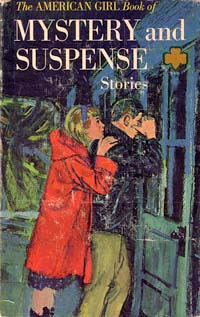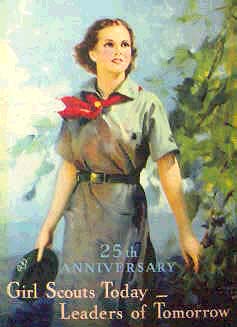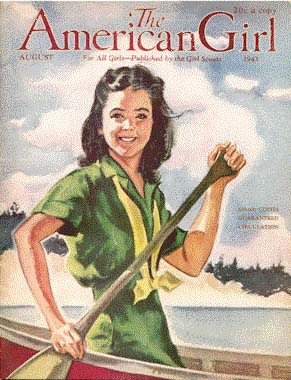|
 Originally published in 1945, this anthology consists of ten stories selected by the editors of American Girl magazine, which was -- and still may be (they drummed me out of the Corps decades ago) -- the magazine for the Girl Scouts of America. Originally published in 1945, this anthology consists of ten stories selected by the editors of American Girl magazine, which was -- and still may be (they drummed me out of the Corps decades ago) -- the magazine for the Girl Scouts of America.
Generally speaking, what we have here (and it helps to keep a historical perspective) are ten wholesome girls in skirts and pumps taking lady-like bites out of crime and making mini-sacrifices in the interests of their dawning womanhood. Or possibly Civilization; I think the two are related. Unlike the adventure stories for boys written around the same time (Nazis and lion hunts anyone?) these stories are pretty darn tame. Maybe 'domesticated' is the word.
Which is interesting because 1945 was kind of a challenging time for American women. WWII was winding up; the American woman had had her hands full keeping the world turning for the past couple of years. Now her role would change again -- as would her place in the work force. Meanwhile, at the movies we had Mildred Pierce, Spellbound and National Velvet -- all featuring strong roles for women. The Golden Age of mystery writing was coming to an end. Agatha Christie still reigned, though Miss Marple, the quintessential spinster sleuth, only made two appearances during the 1940s. But female American mystery writers like Leslie Ford and Mignon Eberhart were churning stories out like there was no tomorrow, and for awhile that had seemed a possibility.
Margaret Leighton's "The Legacy of Canyon John" kicks off. Interestingly, the first words spoken in this anthology are by a boy, the heroine's neighbor and "inseparable companion" since babyhood. Jerry (the boy) definitely gets the action role in this story, with spunky Linda reduced to suggesting they call the sheriff, the park ranger, their parents, SOMEONE. Silently she hopes Jerry doesn't get them both killed. However, on a positive note, we see two American teenagers working together to earn money for their college education. College and education are every bit as important to Linda as Jerry.
I'd like to think that "Night Flight" by Eloise Engle made a statement in its day. Here we have Flight Nurse Captain Lyn Guild who risks her engagement to volunteer for a hopeless mission (keeping a premature baby alive on a long distance flight). Okay, it's baby-related and what red-blooded American girl could refuse the needs of a baby? Plus, Lyn is a nurse, which was one of the respectable "female" careers, but she is a ranking officer and she does risk that all-important Engagement. There's no mystery here and the suspense revolves around whether the baby and Lyn's relationship with Bill can survive this arduous flight.
 Ought she to apologize for being so foolishly dedicated to her profession? The look on Bill's face was her answer. She would never have to explain or apologize again. "A nurse like you," he said, squeezing her hand and smiling down at her, "would sure make a good mother" Ought she to apologize for being so foolishly dedicated to her profession? The look on Bill's face was her answer. She would never have to explain or apologize again. "A nurse like you," he said, squeezing her hand and smiling down at her, "would sure make a good mother"
Well, gee, Bill. I thought you already had a mother.
"Strange House" by Flo Penglase is first person narrated by a nameless college girl who spends a couple of nights in a New York brown stone closed for the summer. The point here is that our heroine doesn't bail when the spooky stuff starts. She imagines what her father would say: "Stand on your own two feet, Minx. A certain amount of independence is good for you" A certain amount sure. Anyway, that man should be arrested for naming his daughter, "Minx"
(Okay, okay. Maybe I'm over-sensitive to the hint of male patronization. Still, it boggles my mind to think that these stories were written -- well, published -- post WWII. By 1945, women had spent a few years responsible for keeping a lot more than the home fires burning.)
"Spring Tornado" is written by Joe Christy, who may be male, which would explain the fact that there's some action in this one. We've got another girl struggling to get the money together for college, small, pixie-eyed Debbie Mills. I'm not sure what "pixie-eyed" means (poor kid). According to Debbie's DAD, the Debster is a terrific "natural pilot" And in "Spring Tornado" she risks her all to help some stranded travelers. So here we see several important themes: the relationship between the American girl and her pop; the American girl's desire for a college education (in two stories at least this entails not following the path her family would prefer); the American girl's proficiency at non-traditional skills like flying; and the American girl's willingness to sacrifice her engagement, school funds and even life (in this case) for the welfare of others. Most of the stories in this collection reflect some, if not all, of these motifs. And, in fact, there's nothing to jeer at in any of this.
Chesley Kahmann steers us back to mystery with "The Boathouse Mystery" Again, the first words spoken are by a boy, Dick Huston, "High School Class President" The story's heroine, Gail McCune takes a more active role here, but half her mind is always on Dick. Still, teenage girls are generally preoccupied with teenaged boys, so I can't fault the veracity, and this is one of the only stories that actually contains an element of crime or mystery. It does bother me that Dick is such a -- well -- jerk. And yet Gail still prefers him to sensible and appreciative Bill. I guess it's the realism in this one that gets to me.
"Locked In," by Skulda V. Baner is one of the weakest in the collection. Here we have the annoying Valborg (these ethnic American girls!) who, after working months at the department store, still stutters and stammers with awe when she runs into her employer (a man, naturally). Valborg's dilemma seems to be whether she should buy her mother a wonderful birthday gift or herself a ski jacket. The fact that this is a dilemma is a little unsettling. V. manages to get herself locked inside the department store with a small boy. (Someone should do something about that store's security team!) After she puts the kid to sleep by droning on about her ethical pickle, Valborg decides not to go on the ski trip her boyfriend is so looking forward to because she can't have the new ski jacket.
Larry wouldn't understand, being a boy, how she felt about going in old makeshift ski things, when every other girl in Elms High who was going north would have a nice new ski outfit to wear.
Stop! The suspense is killing me.
"Kay Uses The Evidence" by Martha Johnson gives us yet another nurturing female. Not that I have anything against nurturing females. (I could be nurturing if I wanted to!) Anyway, Kay Allen is a Volunteer Aide at the Crestwood Hospital Children's Ward. Note again the message here: nursing careers get the thumbs up, especially if nursing children is involved. Kay uses her keen powers of detection to locate an ailing boy's missing pooch.
Yep, there's a recognizable pattern--and you don't have to be a detective to spot it.
Elizabeth Eicher's "Fire at Egg Ranch" (stop snickering) gives us Vicky Bronner, who has had it with life on a chicken ranch. However she pitches in to help save the family homestead when fire threatens. I suspect that Vicky set the fire and then tried to cover her tracks by fighting side by side with everyone else to save the old chicken coop.
 Gladys V. Bauer writes well in "Prowlers in the Night" Our heroine is Bitsey Melville, "Pretty, shy and small for sixteen" This is a nice moody piece about a girl who foregoes starting her vacation to check on her curmudgeonly aunt. Not a bad little story, and a decent moral about facing down your fears. American girls have a lot of fears. But, that's pretty much adolescence, isn't it? Gladys V. Bauer writes well in "Prowlers in the Night" Our heroine is Bitsey Melville, "Pretty, shy and small for sixteen" This is a nice moody piece about a girl who foregoes starting her vacation to check on her curmudgeonly aunt. Not a bad little story, and a decent moral about facing down your fears. American girls have a lot of fears. But, that's pretty much adolescence, isn't it?
THE AMERICAN GIRL BOOK OF MYSTERY AND SUSPENSE STORIES winds up with Ruth Gilbert Cochran's "Amateur Sleuth." Elly Trask and her "unpredictable steady" Butch have one of those modern relationships.
He didn't mind Elly's tendency to backseat driving, and they both knew that if she ever got a bit too executive he would tell her so in no uncertain terms.
Well, let's face it, nagging is annoying in anyone. The quest here is to earn money for school supplies and field trips. Butch tackles -- literally --an escaped convict. Elly "cowers," "quavers," "pleads" and finally runs to get help.
Great. We end with Butch (a boy) having the last word. Butch's last words are, "Oh Elly, why do I let you get me into these things!"
I don't know why, but that cracks me up. What's even funnier to me is that while these stories were first published in 1945, the copy I have is dated 1964. You'd think stories written in 1945 might not have the same relevancy for girls in 1964, but apparently certain things spring eternal. For example, THE AMERICAN GIRL BOOK OF MYSTERY AND SUSPENSE STORIES turned out to be part of a popular series of books on topics dear to the American Girl's heart: Horse Stories, First Date Stories; and Teenage Questions (the mind reels). Oh, and let's not forget THE AMERICAN GIRL BEAUTY BOOK.
Witch hazel, ladies?
|

